Did you know that more than 36 million people in America are missing all their upper and/or lower teeth?
It’s staggering! And it gets worse as we age. According to recent statistics reported by the Centers for Disease Control and Prevention (The CDC), 17% of adults 65 and older are completely edentulous (have no natural teeth), and 90% of those who are missing all of their teeth wear removable dentures.
Losing teeth can be a life-altering experience, affecting not only your ability to eat and speak but also your self-confidence and overall quality of life. Fortunately, dental technology has evolved significantly over the past several decades and provided us with effective solutions for replacing missing teeth. Thanks to dental implants, we can replace missing teeth with a very high rate of success.
Dental implants are titanium posts (screws) that are placed in the jawbone to replace the root(s) of missing teeth. They provide an anchor for a variety of tooth replacement options. Implants can be used for replacing just a single tooth, up to an entire arch of teeth, effectively returning us to full functionality.
Here are a few ways dental implants are used to replace missing teeth:
Dental implants can effectively replace a single tooth by replacing the missing tooth with a single dental implant with a crown on it.
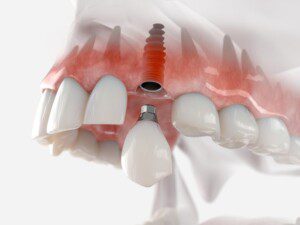
They can also be used to replace several missing teeth in a row. For instance, with the use of two dental implants with porcelain or zirconia bridges that are permanently attached to them.
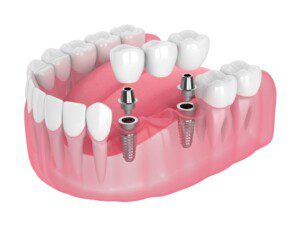
They can also be used to replace an entire arch of teeth or a full mouth of teeth.
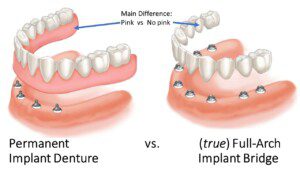
If you are missing an entire arch of teeth missing (all uppers or all lowers), there are two fixed and one removable prosthetic options involving dental implants. If you don’t want conventional (removable) dentures, but still want to be able to take your prosthesis out for easy cleaning, overdentures (often referred to as removable snap-on dentures) are a great option. Overdentures are significantly more stable than conventional dentures because they “snap” on and off of the implants and are removable for cleansing purposes. This option may be preferable to someone who has difficulty cleaning their teeth. They are also less expensive than full arch implant bridges.
There are two “fixed” (non-removable) full-arch tooth replacement options available:
- Full-Arch Fixed Implant Bridges (to be explained in full on this page), or
- Fixed Implant Dentures (also referred to as All-On-4).
This page will focus on these two options and review them both in detail.
Teeth can be lost for many reasons, including periodontal disease, decay, breakage from severe grinding, injury, and other dental complications. Before dental implants came on the scene, denture wearers only had a tiny bit of suction to help them keep their teeth in place. Patients have suffered with wearing removable dentures since they were first used to replace teeth. They had no choice; there was no alternative. Dentures were the ONLY option. Not so anymore.
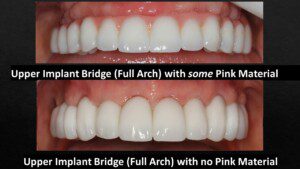
What Is A (Full Arch) Fixed Implant Bridge?
Full arch implant bridges are THE BEST tooth replacement option for replacing a full arch of teeth (all uppers or all lowers). They are screwed into the mouth onto implants placed in the jawbone. Full arch implant bridges can be made as a single-unit bridge that spans the entire arch, or in sections, replacing all upper teeth or all lower teeth (sometimes called 3 on 6; 3 bridges on 6 implants). They are called “fixed” because they are screwed into the mouth, and not removable by the patient. These days, most are made of zirconia. They are significantly thinner and much less bulky than other prosthetic options, so they feel MOST like natural teeth. There is no palate, like with a denture.
Here at The Dental Implant Center, we make Implant Bridges for patients virtually every day. They are truly life-changing for people who have suffered with a variety of dental problems and have gotten to the point where they need all their teeth replaced.
The process of getting fixed Implant Bridges does require dental implants to secure them in place. We manage all phases of treatment here under one roof. The surgery is done in-office, only takes a few hours, is far less painful than you might think, and you leave the office with a full set of (temporary) teeth.
THERE ARE TWO TYPES OF FIXED IMPLANT BRIDGES:
- Bridges with NO pink material on them,
- and bridges with SOME pink material on them.
What Is A Fixed Implant Bridge (Without Pink Material)?
This bridge consists of only the teeth, with no fake gums. It’s nice and thin and doesn’t take up any more room than natural teeth did when they were present. Notice how the scalloped edges where it meets the gumline are shaped just like natural teeth? This is designed this way on purpose, with much care in developing the patient’s gum tissues after the surgery and during the healing and temporization phase of treatment, for a final result that looks both natural and beautiful.
This is the most ideal and realistic looking/feeling full-arch prosthetic tooth replacement available. You’ll notice one MAJOR, immediately visible difference between this bridge and all the implant bridges and implant dentures (All-On-4) you see advertised: The gums. That’s right; the pink part. With this kind of implant bridge, there is NO PINK material on the prosthesis. The gums are all your own, and the prosthesis consists of ONLY the teeth.
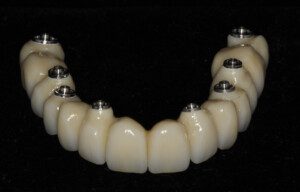
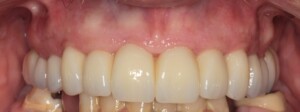
What Is A Fixed Implant Bridge? (With Pink)?
For patients who have been missing teeth for a while, and/or who have lost significant bone and gum structure, implant bridges without any pink whatsoever, is not always possible, because of their limited anatomy. And although in some cases, bone grafting can help, other times, even bone grafting won’t yield enough bone to replace what’s been lost over many years.
In cases such as these, there is a variation of the implant bridge which has some pink material built into it. This pink part is custom shaded to match the patient’s gum color, for a seamless, natural look. The bridge fits snugly up against the gums, and like other implant bridges, is done so in a convex manner so it is easy to keep clean. One thing patients love about them is that they are not bulky, like implant dentures. This makes them easier to speak and chew without retraining their tongues and cheeks to adapt and accommodate the bulkier Implant Denture/All-On-4 prostheses.
For some patients with moderate bone height loss, simply making the teeth a little bit longer may work esthetically, but for others, with more loss of bone height, there’s just too much space to fill, and so adding some pink material is the best esthetic way to deal with this.
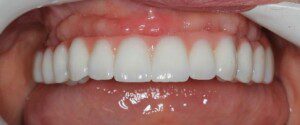
What Is A Fixed Implant Denture?
A fixed Implant Bridge, commonly known as the All-On-4 prosthesis, is screwed into the mouth onto implants. A fixed denture is a single-unit prosthesis that spans the entire arch, replacing all the teeth in that arch (all upper teeth or all lower teeth). It is called “fixed” because it is screwed into the mouth. Unlike removable dentures, which can be taken out of the mouth by the patient for cleaning and maintenance, fixed dentures are permanently attached to dental implants and can only be removed by a dentist.
Fixed dentures offer several advantages, including improved chewing and stability and compared to removable dentures. They feel and look more like natural teeth than a removable denture. However, the process of getting fixed dentures requires the surgical removal of a significant amount of bone and the use of angled implants and angled correction abutments, which, long-term, do not do as well as implants placed in the more natural and ideal position (vertically, just like a tooth root).
The surgery is done in-office, only takes a few hours, and you leave the office with a full set of (temporary) teeth. The downside to an Implant Denture vs an Implant Bridge, is the concave design of the underside of the prosthesis, where it meets the gums. These concavities allow for plaque and food accumulation and are very difficult, if not impossible to clean thoroughly.

How Are Fixed Bridges And Fixed Dentures Alike?
Both Fixed Implant Bridges and Fixed Implant Dentures involve dental implants, and both are “fixed”, (screwed in) to your mouth. Just looking at your smile, most people cannot tell the difference between the two. Both options provide a beautiful smile, but there are some key differences, and this page will explain those differences and go over the reasons one might choose, or only be a candidate for one over the other.
Some Key Likenesses:
- Beautiful smile
- Solid chewing ability, no teeth shifting while you chew
- Permanent tooth replacement
- Screwed in (Don’t need to take them out to clean them)
- No parts need to be regularly replaced (like in the case of a removable implant denture)
- Once healed, you can eat any foods you want with confidence
- Both are cleaned like natural teeth, by regular brushing, flossing, etc.
In this photo, one is a Fixed Implant Bridge and the other is a Fixed Implant Denture. From this (smile) view, can you tell the difference?
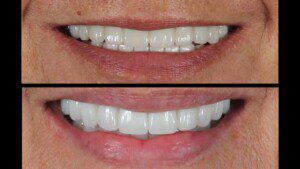
The one on top is an Implant Denture and the one on the bottom is an Implant Bridge. Although the lady on the top, wanted yellower teeth because her natural teeth were yellow, and she was up in her years and didn’t want bright white teeth: Their smiles both look nice, don’t they? So, WHY is one a preferred/better option (when it is possible) than the other? Let us dig a little deeper.
How Are Fixed Bridges And Fixed Dentures Different?
A lot of patients do not like the word, “dentures”, so a LOT of offices that provide this treatment, in order to make it more palatable to the patients, CALL THEM “Implant Bridges”, because it is a one-piece prosthesis that “bridges” across the entire arch, replacing all 12-14 teeth. But this term can be very misleading. There are a lot of marketing terms thrown around in dentistry and it’s important that you understand just what the differences are for full arch or full mouth tooth replacement options, so you know just what questions to ask when discussing treatment, so you know whether you’re discussing an Implant Denture or a true, Implant Bridge.
Some Key Differences:
- There is (usually) no “pink” porcelain or zirconia on the implant bridge prosthesis. The gums are the patient’s own healthy, pink gums. In some cases, there must be some pink, if there was a significant amount of bone loss prior to treatment.
- There is not massive bone removal for implant bridges like there is for and Implant Denture/All-On-4 procedure.
- The papillae are preserved, allowing for a very natural look and feel of the teeth against the gums.
- An Implant Bridge is thinner and less bulky than an Implant Denture, so it feels more like real teeth.
- Implant Bridges are easier to keep clean.
- Implant Bridges have no food entrapment issues between the prosthesis and gums.
- There are no angled implants or abutments causing problems years down the road (All-On-4 specifically uses angled implants and angled abutments), and as a result of NOT using angled parts and pieces, there’s
- Less bone loss around the implants from the angled forces on them over time
- Less tissue resorption around the implants over time from the bone loss
- Less risk of failure due to the above two mentioned
So, you might ask: WHY is everyone doing the bulky, harder to clean option with all the pink? Well, in most cases, it’s simply that the doctor doing the treatment doesn’t/can’t do that treatment. They sell you the “permanent teeth” in a day idea, which sounds great, in the short term, but, is it really?
Now, compare these to the photos above (where we asked if you could tell the difference between the two) to this next one. This time, with lips-retracted views, showing what is underneath, when the lips and cheeks are pulled back. What differences do you see?
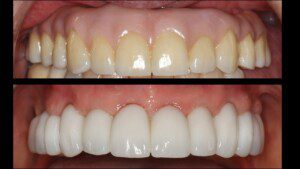
Is All-On-4 An Implant Bridge Or An Implant Denture?
The All-On-4 Implant Denture has gained massive public popularity over the past decade or so. It was originally done only for patients who did not have enough bone available (denture wearers) for proper implant positioning, but who did have just enough bone to place implants at odd, steeply angled positions, to lend some support for false teeth. And – it was life-changing for many patients who otherwise, would’ve only had one option: Conventional removable dentures.
Compared to regular dentures, and a last resort, it served a lot of people well. But then it got so heavily marketed that many dentists started selling it to everyone who wanted full arch or full mouth replacement because patients started asking for it by name, not knowing there IS a better alternative. So, why aren’t more dentists performing Implant Bridges? The short answer is that Implant Bridges are exceptionally difficult both surgically and prosthetically. Even simpler, only a tiny fraction of dentists has the skills to do them. And, sadly, a fraction of that fraction that could do them, have sold out to the easier treatment of All-on-4.
Most corporate dental implant centers easily do two patients or four arches (jaws) in one day. How is that possible? Because every patient’s treatment is the same. How is that possible if each patient is unique? By removing bone down to a flat platform each patient is essentially the same patient. It is called, “assembly line implant dentistry”.
The All-On-4 protocol involves removing (often) massive amounts of bone to make the ridge flat and uniform, and to create enough space for the prosthesis, then placing the back implants at steep angles so they could fit implants into the small spaces where there was slightly more bone. This angled approach allows longer implants to integrate with the bone, which is great, initially. But using angled implants means the need for angled abutments, as well.
The problem with this is that over time, the vertical chewing forces placed on these angled implants and parts often causes mechanical failure problems. Those, in turn, lead to biological problems that aren’t seen until years after they’ve been screwed into the patient’s mouth. Patients with heavy bites or with a habit of grinding or clenching their teeth are particularly prone to problems with biological and mechanical demise.
For many All-0n-4 patients the problems begin immediately after surgery (due to the massive bone removal and angled abutments). Others don’t experience problems until several years later. Problems like, the implants becoming exposed because of bone loss around them from the, and/or soft tissue loss, exposing the body of the implant to the elements and accumulating plaque and debris, and proving difficult to keep clean, resulting in a slow downhill slide of events.
Dr. McFadden, a Board-Certified Prosthodontist and implant surgeon for over 34 years, has seen many, many cases where the above-mentioned problems have led to severe complications and even failure for such patients. For decades he has worked diligently to come up with a treatment protocol for patients who need full arch or full mouth tooth replacement with a better and more long-term, successful solution. He’s become a leader in providing patients with true Implant Bridges in cases where other doctors are all pushing the All-On-4 or similarly labeled Implant Dentures. How? By taking more time in the planning, and in the treatment. By NOT removing bone and strategically planning for and placing implants in exactly the right position and angles to allow for life-long use, without the complications that bulky, or angled-implant supported implant dentures come with.
Over the past 25 years or so now, he’s developed a treatment protocol that not only has improved the long-term success of, and reduced complications of these issues, but also greatly improved the esthetic outcome. It took time and practice to hone this treatment modality down to what it is now, but it has all proved worthwhile. Today, for patients looking for an alternative to the All-On-4 treatment protocol, he provides full, true, Implant Bridges for patients from all over the country, virtually every single day he’s here in the office.
Why Implant Bridges Are A Better Alternative To All-On-4/Implant Dentures
It’s obvious from what you’ve read and seen here so far, that if everyone had a choice, they’d choose Implant Bridges over Implant Dentures. So, why can’t they get them anywhere? Why don’t all implant dentists and prosthodontists offer them? That’s a three-fold answer. The main answer is that most dentists don’t have the technical skill and the patience to do it. Sadly. Secondly, the All-On-4 treatment has become so wildly popular that many of them feel pressured into doing it to “give patients what they (think they) want”, even though most patients have no real understanding of the treatment for which they have requested by name. Marketing is POWERFUL! Thirdly, for the doctor, it is much easier and more lucrative.
Dr. McFadden has many informative videos on this topic.
So, in a nutshell: The biggest differences between a full arch Implant Bridge and an Implant Denture are:
The All-On-4/Implant Denture has
- the massive amount of bone that is removed to prepare the jaw for it
- the use of angled implants and
- angled abutments, and
- lots of pink material on the prosthesis, making it bulky with spaces between the prosthesis and gums, making it very difficult to clean under.
So, let’s discuss this a little deeper. Let’s explore just what is involved in these two tooth replacement solutions to help you make an informed decision.
How Do You Clean Them?
Since they’re screwed in, and solidly secured in your mouth like regular teeth, you clean them like you would bridges on natural teeth: By regular brushing, flossing under them with floss-threaders, water-picking, and for some patients, using other special cleaning tools. Also remember, it’s important to stay on track with periodic cleanings and checkups.
Let’s Recap With Some More Photos Of Both Treatment Options:
Fixed Implant Dentures (Upper and Lower Arches):
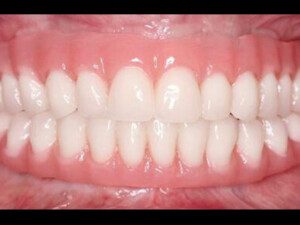
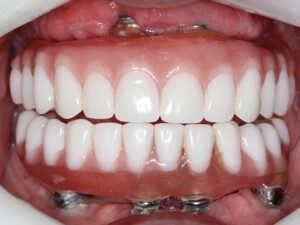
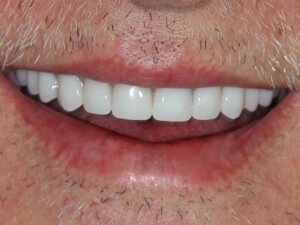
Fixed Implant Bridge (Upper Arch):
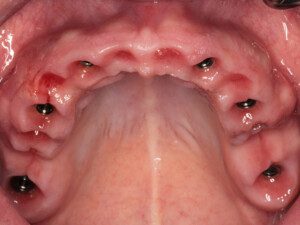
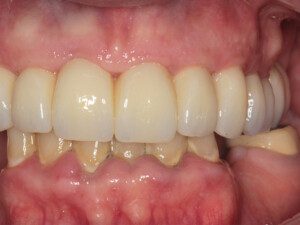
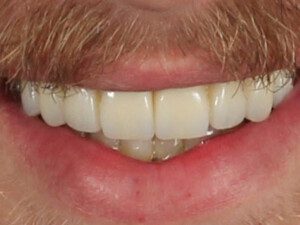
Which Option Is Right For You?
The best way to find out whether Implant Bridges or Implant Dentures are the right choice for you is to consult with an experienced Implant Prosthodontist. Specialists like Dr. McFadden or Dr. Tan. Several factors need to be assessed and considered before deciding which option is best for your individual circumstances.
Implant Bridges are THE MOST natural looking, natural feeling, least bulky and fully functional full arch tooth replacement option for someone missing all their teeth. Hands down! Every dentist on the planet, if ever faced with total tooth loss themselves, would opt for a true Implant Bridge over an All-On-4 denture or other Implant Denture. Every. Single. One.
As explained above, in some cases, having pink porcelain or zirconia on the prosthesis is inevitable. The good news is that MOST patients we see do qualify for them. (About 80% of the Implant Bridges we do in our office have no pink.)
|
What Is The Cost?
How much you can expect to pay for this treatment varies significantly and depends on factors. Things like your location, the dentist’s qualifications, type of dental implants, number of implants needed, and the materials used for the final restoration. Generally, the total cost of treatment falls within the range of $25,000 to $45,000 per arch.
Conclusion
In summary, if you are facing complete tooth loss in one arch or require the extraction of all of your teeth, you have sufficient bone support for 4-8 implants, prefer a permanent tooth replacement solution over removable options, and have the financial means for this treatment, this represents an outstanding method to fully restore your mouth both functionally and aesthetically.
This treatment can often be undertaken incrementally, with longer intervals between the various stages. This approach allows for a more extended overall treatment timeline and, consequently, more manageable payments. Unlike many other dental implant practices, we do not require you to pay upfront for unfinished steps in the process. We believe in a fair pay-as-you-go approach.
Find out how we can help restore your confidence and oral health. Contact us today to schedule a complimentary consultation.

